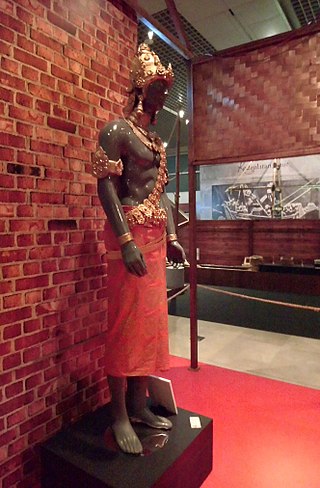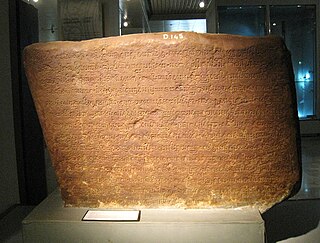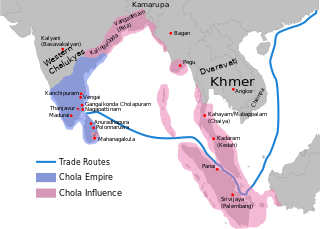Dharmasraya is the capital of the 11th century Buddhist polity known as Melayu Kingdom, based on the Batanghari river system in modern-day West Sumatra and Jambi, on the island of Sumatra, Indonesia. [1] The kingdom itself could be identified by the name of its capital Dharmasraya or by the name Bhumi Malayu or Suvarnnabhumi according to Padang Roco Inscription.
After the invasion by Rajendra Chola I the king of the Chola Empire from Koromandel, authority of Sailendra dynasty over the islands of Sumatera and the Malay Peninsula weakened. Some time later came a new dynasty that took over the role of Sailendra Dynasty, called by the name of Mauli dynasty. [2] The Dharmasraya can be considered as the successor of Srivijaya.
The oldest inscription bearing the name of Maharaja Mauli is the Grahi inscription dated 1183 discovered in Chaiya (Grahi) Malay Peninsula, Southern Thailand. The inscription bears the order of Maharaja Srimat Trailokyaraja Maulibhusana Warmadewa to the bhupati (regent) of Grahi named Mahasenapati Galanai to make a statue of Buddha weight 1 bhara 2 tula with the value of 10 gold tamlin. The artist name that responsible to create the statue is Mraten Sri Nano.
The second inscription from Mauli dynasty appear approximately a hundred years later in 1286. The inscription in which the name Dharmasraya (and the name of king Srimat Tribhuwanaraja Mauli Warmadewa) appears dates from the 13th century, [3] : 201 namely the Padang Roco inscription discovered around the headwaters of Batanghari river (now Dharmasraya Regency in West Sumatera), dated 1286.
The Maharajas of Dharmasraya:
| Date | King's of name | Capital | Stone inscription or embassies to China and events |
|---|---|---|---|
| 1183 | Srimat Trailokyaraja Maulibhusana Warmadewa | Dharmasraya | Grahi inscription 1183 at Chaiya, South of Thailand, the order to regent Grahi, namely Mahasenapati Galanai to make a Buddha stone. |
| 1286 | Srimat Tribhuwanaraja Mauli Warmadewa | Dharmasraya | Padang Roco inscription 1286 at Siguntur, (now Dharmasraya regency), Pamalayu expedition. |
| 1347 | Srimat Sri Udayadityawarman Pratapaparakrama Rajendra Mauli Warmadewa | Pagaruyung | Moved to Pagaruyung Amoghapasa Statue 1347 at Dharmasraya, Kuburajo inscription at Pagaruyung (now Tanah Datar regency). |

Srivijaya, also spelled Sri Vijaya, was a Buddhist thalassocratic empire based on the island of Sumatra that influenced much of Southeast Asia. Srivijaya was an important centre for the expansion of Buddhism from the 7th to 11th century AD. Srivijaya was the first polity to dominate much of western Maritime Southeast Asia. Due to its location, Srivijaya developed complex technology utilizing maritime resources. In addition, its economy became progressively reliant on the booming trade in the region, thus transforming it into a prestige goods-based economy.

South Sumatra is a province of Indonesia, located in the southeast of the island of Sumatra. The capital and largest city of the province is the city of Palembang. The province borders the provinces of Jambi to the north, Bengkulu to the west and Lampung to the south, as well a maritime border with the Bangka Belitung Islands to the east. It is the largest province in the island of Sumatra, and it is slightly smaller than Portugal. The Bangka Strait in the east separates South Sumatra and the island of Bangka, which is part of the Bangka Belitung Islands province. The province has an area of 91,592.43 km2 (35,364 sq mi) and had a population of 8,467,432 at the 2020 Census; the official estimate as at mid-2023 was 8,743,522. The province is rich in natural resources, such as petroleum, natural gas and coal. The province is inhabited by many different malay sub ethnic groups, with Palembangese being largest ethnic group. Most speak the Palembang language, which is mutually intelligible to both Indonesian and local Palembang Malay. Other ethnic groups include the Javanese, Sundanese, Minangkabau and Chinese. Most are concentrated in urban areas and are largely immigrants from other parts of Indonesia.

The Shailendra dynasty was the name of a notable Indianised dynasty that emerged in 8th-century Java, whose reign signified a cultural renaissance in the region. The Shailendras were active promoters of Mahayana Buddhism and covered the Kedu Plain of Central Java with Buddhist monuments, one of which is the colossal stupa of Borobudur, now a UNESCO World Heritage Site.

Adityawarman was a king of Malayapura Suvarnabhumi, and is the successor of the Mauli dynasty based in central Sumatra. He was the cousin of Jayanegara, king of Majapahit from 1309 to 1328, and the grandson of Tribhuwanaraja, king of Melayu Kingdom. Adityawarman was awarded the Senior Minister of Majapahit (wreddamantri) and used this authority to launch Majapahit military expansion plans and conquer east coast region in Sumatra. Adityawarman then founded the royal dynasty of Minangkabau in Pagaruyung and presided over the central Sumatra region to take control of the gold trade between 1347 and 1375.

The Melayu Kingdom was a classical Buddhist kingdom located in what is now the Indonesian province of Jambi in Sumatra.

The Pamalayu campaign was a diplomatic and military expeditionary force sent by the Javanese King Kertanegara of Singhasari to conquer the Sumatran Melayu Kingdom. It was decreed in 1275, though perhaps not undertaken until later.

Malay Indonesians are ethnic Malays living throughout Indonesia. They are one of the indigenous peoples of the country. Indonesian, the national language of Indonesia, is a standardized form of Riau Malay. There were numerous kingdoms associated with the Indonesian Malays along with other ethnicities in what is now Indonesia, mainly on the islands of Borneo and Sumatra. These included Srivijaya, the Melayu Kingdom, Dharmasraya, the Sultanate of Deli, the Sultanate of Siak Sri Indrapura, the Riau-Lingga Sultanate, the Sultanate of Bulungan, Pontianak Sultanate, and the Sultanate of Sambas. The 2010 census states that there are 8 million Malays in Indonesia; this number comes from the classification of Malays in East Sumatra and the coast of Kalimantan which is recognized by the Indonesian government. This classification is different from the Malaysia and Singapore census which includes all ethnic Muslims from the Indonesian archipelago as Malays.

Balaputradewa was the maharaja of Srivijaya in the 9th century CE as well as the former head of the Sailendra dynasty. He was the youngest son of the preceding Sailendran maharaja, Samaratunga, through marriage with Dewi Tara who was in turn the daughter of another maharaja, Dharmasetu of Srivijaya.
Dharmasetu was an 8th-century Maharaja of Srivijaya. Under his reign, he successfully incorporated Pan Pan, a kingdom located in the north of the Malay Peninsula, into the Srivijayan sphere of influence before 775 CE.

Bukit Seguntang or Bukit Siguntang is a 29–30 metres high small hill located at the northern bank of Musi River and within the vicinity of Palembang, capital city of South Sumatra, Indonesia. It is located around 3 kilometres north from Musi River northern bank and around four kilometres southwest from Palembang city center. The place is considered sacred by the locals and home of many archeological relics believed to be related to Srivijaya Empire, once a dominating political power around Malacca Strait. Today the hill gain status as an archaeological park.

The Padang Roco Inscription, in Indonesian Prasasti Padang Roco, is an inscription dated 1286 CE, discovered near the source of Batanghari river, Padangroco temple complex, Nagari Siguntur, Sitiung, Dharmasraya Regency, West Sumatra, Indonesia.

Inscriptions and historical sources assert that the Medieval Chola Emperor Rajendra I sent a naval expedition to Indochina, the Indonesia and Malay Peninsula in 1025 in order to subdue Srivijaya. The Thiruvalangadu plates, the Leyden grant, and the Tamil stele of Rajendra I are the principal sources of information about the campaign.
Dara Jingga, was one of the Malay Dharmasraya princess who was intended to be betrothed to Javanese King Kertanegara of Singasari after the Pamalayu expedition 1275–1293.

In 1025 CE, the Chola Emperor Rajendra I launched naval raids on Srivijaya in maritime Southeast Asia, Rajendra's overseas expedition against Srivijaya was a unique event in India's history and its otherwise peaceful relations with the states of Southeast Asia. Several places in present-day Indonesia and Malay Peninsula were invaded by Rajendra I of the Chola dynasty. The Chola invasion furthered the expansion of Tamil merchant associations such as the Manigramam, Ayyavole and Ainnurruvar into Southeast Asia. The Cholan invasion led to the fall of the Sailendra Dynasty of Srivijaya and the Chola invasion also coincides with return voyage of the great Bengali Buddhist scholar Atiśa from Sumatra to India and Tibet in 1025 CE.

Pannai, Panai or Pane was a Buddhist kingdom located on the east coast of Northern Sumatra that existed between the 11th and 14th centuries. The kingdom was located on the Barumun River and Panai River valleys, in today's Labuhan Batu and South Tapanuli regencies. Because surviving inscriptions and historical records of this period are scarce, the kingdom is among the least known political entities in Indonesian history. Historians suggest that Pannai was probably a principality or a vassal allied under the Srivijayan mandala and later to Dharmasraya kingdom.

Mauli was a dynasty of kings that ruled the Bhumi Malayu or Dharmasraya kingdom, centered in the Batanghari river system, from the 11th century to the 14th century. Most Mauli kings were Mahayana—Vajrayana Buddhists.
Dharanindra or commonly known as King Indra was the ruler of the Sailendra dynasty who was the Emperor of Mataram in Central Java and Srivijaya in South Sumatera. Dharanindra was the successor of Panangkaran, he ruled the kingdom in the period 775—800. He was mentioned as a great conqueror and credited for Sailendra's overseas campaign.
Adwayawarman was the father of King Adityawarman of Malayapura kingdom as mentioned in the Kuburajo I Inscription. His alias name was Adwayadwaja, as he was called in the Bukit Gombak Inscription.

Sri Maharaja Srimat Tribhuwanaraja Mauliwarmadewa was a king of Dharmasraya in Bhumi Malayu (Sumatra), as written on the Padang Roco inscription (1286).
Grahi inscription is an inscription found in Chaiya, southern Thailand, written in Old Khmer language with Old Sumatran script, and dated to 1183 CE. This inscription is written on the pedestal of a bronze Buddha statue, that is stored at Wat Hua Wiang temple. The name Grahi, called Kia-lo-hi in Chinese record Zhu Fan Zhi, is considered to be the old name of Chaiya. The city was part of Tambralinga, once a border polity between Srivijaya and Khmer kingdoms in the Malay Peninsula.